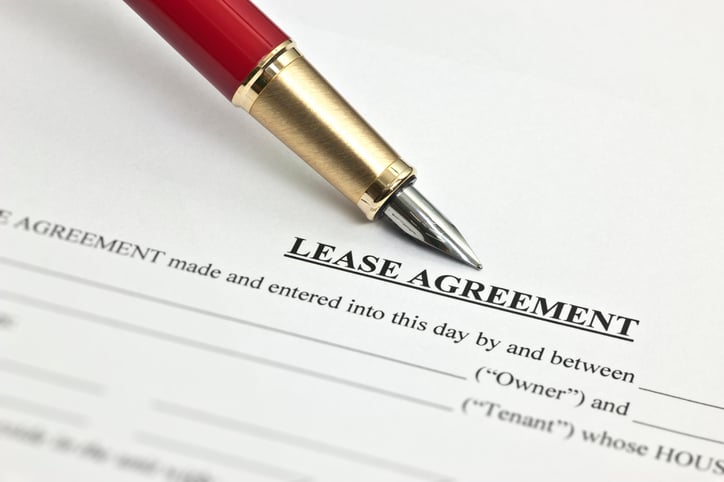Landlords collect money in advance before a tenant moves in. Oftentimes, the funds received from the tenant include a security deposit, prorated rent, and the first month of rent.
In this article, we’ll take an in-depth look at how the first month’s rent works, along with other tips for increasing cash flow and keeping your rental property profitable.
What is First Month’s Rent?
When a new tenant signs a lease, most landlords collect the first month of rent (and usually a separate security deposit as well) prior to the tenant moving in and taking possession of the property.
The first month’s rent is a form of pre-paid or advance rent and, depending upon applicable laws in the jurisdiction where the rental is located, can include additional months such as the first two months of rent, or the first and last month of rent.
Charging the first month’s rent is an easy process, but can sometimes be confusing for new landlords and for tenants who have never rented a home before. In the next section we’ll look at an example of how to handle the first month of rent from an accounting perspective.

Accounting for the First Month of Rent
Let’s assume a home rents for $1,500 per month. The lease is signed on June 15th with a lease start date of July 1st.
You would collect $1,500 from the tenant on June 15th for the first month of rent for July and record that amount as advance rent for July. The tenant’s next rent payment would not be due until August 1st for the month of August, and on the first of each month thereafter.
Here’s how accounting for the first month of rent would appear on a cash flow statement:
| Date | Item | Amount | Tenant Balance |
| June 15th | July first month's rent | $1,500 | <$1,500> |
| July 1st | July rent due | $1,500 | $0 |
| August 1st | August rent due | $1,500 | $1,500 |
| August 1st | August rent paid by tenant | $1,500 | $0 |
At the beginning of the cash flow statement, the tenant has a credit balance because they paid for the July rent in advance on June 15th. When the July rent is due, the first month’s rent the tenant paid on June 15th is applied to the July rent payment.
Going forward the tenant will have no outstanding balance or credit, provided the rent is paid in full and on time.
When to Prorate Rent
Prorating rent and allowing the tenant to move in before the first of the month can be a good way to generate extra rental income and increase potential ROI. That’s because the more cash flow a rental property generates the more valuable it can be.
Let’s assume the home is available and ready to move into on June 15th, the day the tenant signs the lease. The prorated rent for June is calculated like this:
- $1,500 / 30 days in June = $50 per day
- $50 per day x 16 days prorated rent (June 15th through June 30) = $800
When the lease is signed on June 15th, you would collect $800 from the tenant for June prorated rent plus $1,500 for the first month’s rent in July, for a total of $2,300.
Here’s how the above cash flow statement would look if the tenant paid prorated rent from June 15th through June 30th plus the first month’s rent for July:
| Date | Item | Amount | Tenant Balance |
| June 15th | June prorated rent | $800 | <$800> |
| June 15th | July first month's rent | $1,500 | <$2,300> |
| June 15th | June prorated rent paid | $800 | <$1,500> |
| July 1st | July rent due and paid | $1,500 | $0 |
| August 1st | August rent due | $1,500 | $1,500 |
| August 1st | August rent paid by tenant | $1,500 | $0 |

How First Month’s Rent Works in the Leasing Process
By using a free online rental listing service – along with a yard sign and bulletin board advertising - you quickly found several prospective tenants to choose from. After that, you asked each tenant to complete the rental application using your online tenant screening provider.
You selected the most qualified tenant based on objective criteria such as good credit and employment reports, and a rental history report that contained no prior evictions.
Now you’re ready to complete all of the paperwork and collect the first month’s rent by following these steps:
1. Sign the lease with the tenant
Review the main points of the lease with the tenant, including rental amount and due date, late fees, what companies to contact for utilities, and how to make maintenance requests if something in the home needs to be repaired.
Even though you’ll be sending all of this information in a tenant welcome letter, many landlords review the same information more than once. Oftentimes the tenants will be excited about moving into their new home and may not read the lease in detail.
After the tenant has read and understands the lease, both the tenant and the landlord (or the property manager acting on behalf of the landlord) should sign the lease.
2. Collect the first month’s rent
After the lease has been signed, the next step is to collect the first month’s rent from the tenant.
It’s usually not a good idea to accept any money until the lease has been signed and the tenant understands all of the terms and conditions. That’s because the rental agreement is a binding contract to rent the property, and money should only be collected after the tenant has agreed to all of the terms.
In many places, it’s standard business practice to collect the first month’s rent and any other payments in guaranteed funds such as a money order, cashier’s check, or using an online rent payment service.
Finally, schedule a time to meet the renters at the property the day the lease terms begin. Keep the keys in your possession until the move-in date, unless you’ve also collected pro-rated rent and are allowing the tenant to move in before the first of the month.
3. Meet the tenant at the property when the lease begins
There are three main reasons for meeting the tenant at the property in person on the start date of the lease.
The first reason is to give the keys to the tenant. Explain what each key is for, and how to operate other devices such as the garage door opener or alarm system keypad. You can also make sure the renter understands what they will be charged for losing a key or having to call a locksmith if they lock themselves out of the house.
Next, walk through the home with the tenant and complete a move-in checklist together to document the condition of the property when the tenant takes possession.
When the tenant eventually moves out, you’ll complete a move-out checklist to compare the before and after condition of the property, and to see if there is any damage caused by the tenant beyond normal wear and tear.
Filling out the checklist with the tenant also gives you the opportunity to explain to the tenant how items such as the stove and thermostat work, and to answer any questions the tenant has.
Lastly, meeting the tenant at the property when the lease begins let’s you review the key terms and conditions of the lease one final time. Remind the tenant when the next rent payment is due, the grace period and late fee if the rent is not paid on time, and the tenant’s responsibility for keeping the property neat and clean and immediately reporting any maintenance requests.

First Month’s Rent vs. Security Deposit
In addition to collecting the first month’s rent, landlords may also collect a security deposit from the tenant.
While the first month’s rent (and any prorated rent) can only be used to pay for rent, a security deposit may be able to be used to pay for damage caused by the tenant beyond normal wear and tear, and for any unpaid rent.
A security deposit is also treated differently for tax purposes.
According to Tips on Rental Real Estate Income, Deduction and Recordkeeping from the IRS, a security deposit is not considered as rental income unless the deposit will be used for the final payment of rent. Instead, the landlord should record the refundable security deposit received from a tenant as a liability on the property balance sheet.
The maximum security deposit a landlord can collect varies from state to state, but is usually equal to 1 – 2 times the amount of monthly rent.
For example, if the monthly rent on a home is $1,500 and the state landlord-tenant laws allow a maximum security deposit of 1 ½ months, the total amount of money collected from the tenant on June 15th would be:
| Item | Amount |
| First month's rent for July | $1,500 |
| Prorated rent for June | $800 |
| Security deposit | $2,250 |
| Total amount due at lease signing | $4,550 |
Of the total amount of $4,550 collected from the tenant, $2,300 is recorded as rental income and $2,250 is recorded as a security deposit liability on the property balance sheet.
To find specific information about security deposit limits and state landlord-tenant laws, the legal resource website Nolo.com publishes two guides:

Can a Landlord Ask for Last Month’s Rent Too?
A landlord may ask for the last month’s rent in addition to the first month’s rent and a security deposit, provided that the state landlord-tenant laws allow doing so. However, even if the law allows, there are several things to consider before asking for the last month of rent:
- Cash account used by most landlords records income when it is received. That means the last month’s rent received this year would be treated as taxable income in this year, even if the last month of rent will not be credited to the tenant until next year.
- Adding the last month’s rent onto the amount of money a tenant must pay when they sign the lease could make the property unaffordable even for qualified tenants. Before asking for the last month of rent, a landlord should consider what other rental property owners are collecting from tenants.
- Collecting the last month of rent instead of a security deposit isn’t a good idea since advance rent payments can only be used to pay for rent and not damage caused by the tenant. On the other hand, a security deposit can usually be used to pay for damages beyond normal wear and tear, in addition to unpaid rent.









